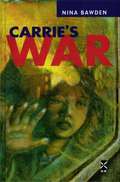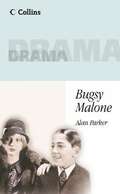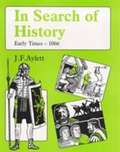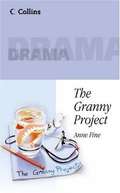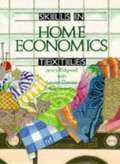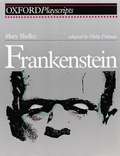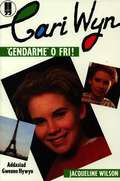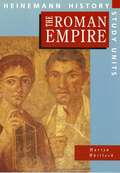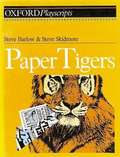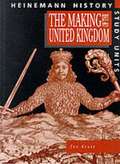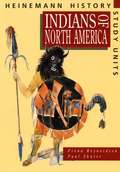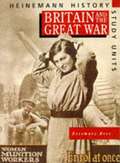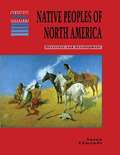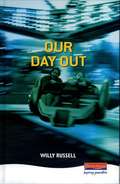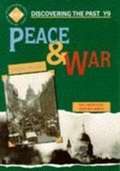- Table View
- List View
Element, Compound and Mixture (Diagram PDF)
by Katie WalkerI have created this resource for a year 7 student with Achromatopsia. This diagram enables the student to identify the difference between an element (1 type of atom), a compound (more than 1 atom chemically bonded) and a mixture (more than one substance). I hope this helps with resource helps.
Carrie's War (PDF)
by Nina BawdenSet in WW2, Carrie and her little brother are evacuated to Wales and billeted at the home of the bullying Mr Evans and his timid sister Lou. Unhappy at home, they love visiting fellow evacuee, Albert, at the farm of Druid's Bottom. Here they meet Hepzibah Green, who knows magical stories, and Mister Johnny, who speaks a language all his own. But then things go wrong and Carrie takes things into her own hands - without guessing the awful consequences.
In Search of History: Early Times - 1066 (PDF)
by John F. AylettIn Search of History' is a well established and trusted series which covers British history from early times through to the twentieth century, The material is presented in an enjoyable way and contains a unique blend of social and political history. The author has produced a lively and easy-to-read narrative that is accessible to a wide range of pupils. Extensive use is made of contemporary illustrative sources as well as line drawings, diagrams and cartoons which have been specially selected to stimulate interest and curiosity. Where appropriate, there are evidence sections, using written and visual evidence. Graded questions based on the text and evidence sections are also included to test and develop various skills such as deduction and decision-making
The Granny Project
by Anne FineIvan, Sophie, Tanya and Nicholas are determined to thwart their parents' plans to put their grandmother into a home. Ivan's scheme backfires, however, when he ends up having to look after his grandmother single-handed. This tightly constructed plot revolves around a family drama with a difference. The playscript itself may either be read in class or acted out in drama lessons. The follow-up material explores the 'generation gap' and the issue of old age from many angles, using a wide range of resources and extracts. Students are encouraged to examine stereotyped views of the aged and to think about what it's like being old in society today. Numerous suggestions for improvisation, creative writing, discussion and role play are included. Readership age: 9+.
The Granny Project (PDF)
by Anne FineIvan, Sophie, Tanya and Nicholas are determined to thwart their parents' plans to put their grandmother into a home. Ivan's scheme backfires, however, when he ends up having to look after his grandmother single-handed. This tightly constructed plot revolves around a family drama with a difference. The playscript itself may either be read in class or acted out in drama lessons. The follow-up material explores the 'generation gap' and the issue of old age from many angles, using a wide range of resources and extracts. Students are encouraged to examine stereotyped views of the aged and to think about what it's like being old in society today. Numerous suggestions for improvisation, creative writing, discussion and role play are included. Readership age: 9+.
Skills in Home Economics: Textiles
by Louise Davies Jenny RidgwellSkills in Home Economics is designed to prepare lower secondary pupils for the work they will encounter in GCSE and Standard Grade courses. Each book in the series covers a core area of Home Economics using a problem-solving investigative approach and the activities use real-life labels, data and packaging to introduce pupils to the world around them. The resources and information are all up to date and plenty of help is given to pupils so that they can develop techniques for recording and analysing the results of their investigations. Textiles looks at the use of textiles, different types of fibres, how fibres become fabrics, designing, and cleaning and caring for clothes. It also includes plenty of examples of how technology affects textiles.
Skills in Home Economics: Textiles (1st New edition) (PDF)
by Louise Davies Jenny RidgwellSkills in Home Economics is designed to prepare lower secondary pupils for the work they will encounter in GCSE and Standard Grade courses. Each book in the series covers a core area of Home Economics using a problem-solving investigative approach and the activities use real-life labels, data and packaging to introduce pupils to the world around them. The resources and information are all up to date and plenty of help is given to pupils so that they can develop techniques for recording and analysing the results of their investigations. Textiles looks at the use of textiles, different types of fibres, how fibres become fabrics, designing, and cleaning and caring for clothes. It also includes plenty of examples of how technology affects textiles.
Frankenstein (Oxford Playscripts)
by Philip Pullman Mary Wollenstonecraft ShelleyPart of a series of dramatizations of well-known novels, selected for Key Stage 3 students, this play examines the monster's situation in a sympathetic light, and shows how the experiment to create an artificial human being went horribly wrong.
Frankenstein (Oxford Playscripts) (PDF)
by Philip Pullman Mary Wollenstonecraft ShelleyPart of a series of dramatizations of well-known novels, selected for Key Stage 3 students, this play examines the monster's situation in a sympathetic light, and shows how the experiment to create an artificial human being went horribly wrong.
Cari Wyn "Gendarme" o Fri!
by Jacqueline Wilson Gwenno HywynY drydedd gyfrol o helyntion merch pedair ar ddeg oed sydd â'i bryd ar fod yn dditectif; y tro hwn mae hi'n helpu heddlu Ffrainc yn ystod trip ysgol i Baris. [A Welsh adaptation of Stevie Day: Rat Race in which the would-be detective-heroine lends the French police a hand during a school outing to Paris.] *Datganiad hawlfraint Gwneir y copi hwn dan dermau Rheoliadau (Anabledd) Hawlfraint a Hawliau mewn Perfformiadau 2014 i'w ddefnyddio gan berson sy'n anabl o ran print yn unig. Oni chaniateir gan gyfraith, ni ellir ei gopïo ymhellach, na'i roi i unrhyw berson arall, heb ganiatâd.
Heinemann History Study Units: Student Book (PDF)
by Martyn WhittockFocusing on the Roman Empire, this is one of a history series which offers teachers the flexibility to design their own scheme of work at Key Stage 3 of the National Curriculum.
Paper Tigers
by Steve Barlow Steve SkidmoreThis playscript contains three original, self-contained plays following the adventures of a gang of newspaper boys and girls as they confront such issues as racism, equality and the law. The activity section provides tips on improvisation techniques and exploring character.
Paper Tigers (PDF)
by Steve Barlow Steve SkidmoreThis playscript contains three original, self-contained plays following the adventures of a gang of newspaper boys and girls as they confront such issues as racism, equality and the law. The activity section provides tips on improvisation techniques and exploring character.
The Roman Empire: Student Book
by Martyn WhittockFocusing on the Roman Empire, this is one of a history series which offers teachers the flexibility to design their own scheme of work at Key Stage 3 of the National Curriculum.
Thinking History: The Roman Empire (PDF)
by Simon MasonThis text is written for 11-13 year-olds who want to discover Roman history for themselves. Above all, it aims to make history fun.;Each chapter contains an real-life activity, designed to encourge children to look closely at the evidence provided from which they can build up their own picture of the past. They are challenged for example to take on the role of a Roman architect who's brief is to plan a Roman town. What can they tell from the archaeological remains of real Roman towns? What evidence is available from written observations of visitors to Roman towns? How can chidren get to grips with the technology of Roman buildings?
Thinking History: The Roman Empire
by Simon MasonThis text is written for 11-13 year-olds who want to discover Roman history for themselves. Above all, it aims to make history fun.;Each chapter contains an real-life activity, designed to encourge children to look closely at the evidence provided from which they can build up their own picture of the past. They are challenged for example to take on the role of a Roman architect who's brief is to plan a Roman town. What can they tell from the archaeological remains of real Roman towns? What evidence is available from written observations of visitors to Roman towns? How can chidren get to grips with the technology of Roman buildings?
Heinemann History Study Units: study units (PDF)
by Joe ScottFocusing on the making of the UK, this is one of a history series, modular in structure, which offers teachers the flexibility to design their own scheme of work at Key Stage 3 of the National Curriculum. Each book covers all the core study units and also a wide range of optional units, and aims to be visually stimulating as well as offering activities which develop both skills and understanding. An extensive selection of primary and secondary sources is provided.
Indians of North America: student book (PDF)
by Paul Shuter Fiona ReynoldsonFocusing on the North American Indians, this is one of a history series, modular in structure, which offers teachers the flexibility to design their own scheme of work at Key Stage 3 of the National Curriculum. Each book covers all the core study units and also a wide range of optional units, and aims to be visually stimulating as well as offering activities which develop both skills and understanding. An extensive selection of primary and secondary sources is provided.
Heinemann History Study Units: Student Book. Britain and the Great War (PDF)
by Rosemary ReesFocusing on Britain and World War I, this is one of a history series, modular in structure, which offers teachers the flexibility to design their own scheme of work at Key Stage 3 of the National Curriculum.
Heinemann History Study Units: Student Book. Britain and the Great War (PDF)
by Rosemary ReesFocusing on Britain and World War I, this is one of a history series, modular in structure, which offers teachers the flexibility to design their own scheme of work at Key Stage 3 of the National Curriculum.
Native Peoples of North America: Diversity and Development
by Tony Mcaleavy Susan EdmondsNative Peoples of North America is a supplementary text in the Cambridge History Programme for key stage 3 national curriculum history. It meets the requirements of supplementary study unit category C, examining the history of North American Indians from prehistoric to present times. Pupils are introduced to the cultural diversity of the native Americans and enabled to assess critically the narrow stereotype which has emerged. The culture clash between the native American and the Europeans is explored, particularly through the history of the Sioux, and the consequences for modern Americans are traced. Enquiry-based units pose key historical questions; overview sections introduce and consolidate themes and concepts. Exercises enable pupils to meet all the Attainment targets which can be assessed through the attainment target focus and attainment target grid included in the book.
Our Day Out
by Willy RussellThe Heinemann Plays series offers contemporary drama and classic plays in durable classroom editions. Many have large casts and an equal mix of boy and girl parts. The television play Our Day Out asks what can a group of back-street kids from Liverpool expect from life beyond a rare day out?
Peace and War: pupil book (PDF)
by Colin Shephard Keith Shephard Schools History Project Andy ReidThe Y9 book from the best selling Schools History Project course for Key Stage 3. In a single volume it covers two core units: Britain 1750-1900 and the Twentieth Century World.
Peace and War: pupil book (PDF)
by Colin Shephard Keith Shephard Schools History Project Andy ReidThe Y9 book from the best selling Schools History Project course for Key Stage 3. In a single volume it covers two core units: Britain 1750-1900 and the Twentieth Century World.

